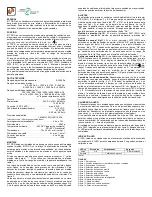
EPSW-TS-RTD-6P-R1
Larson Electronics, LLC
Phone: (800) 369-6671
Fax: (903) 498-3364
www.larsonelectronics.com
2
of
5
Low Voltage DC
Connect power to power supply outputting low voltage between
1 0 - 3 5
Volts
DC. This variable voltage allows greater versatility without affecting light output.
Ensure deutsch connectors are properly connected (If applicable)
HUBS
The EPSW-TS-RTD-6P-R1 contains one 1/2" male NPT hub for process connections
and one 1/2" female NPT hub for conduit connections.
INSTALLATION
1.
Location:
Select a location where the temperature of the transmitter will be between -4 and 158°F. Distance from the
receiver is limited only by total loop resistance.
2.
Position:
The transmitter is not position sensitive. Units with the optional display should be mounted for ease of
viewing the display.
3.
Electrical Connection: Wire Length
- The maximum length of wire connecting the transmitter and receiver is a
function of wire size and receiver resistance. Wiring should not contribute more than 10% of the receiver resistance to
total loop resistance. For extremely long runs (over 1000 feet), choose receivers with lower resistance to minimize the
size and cost of connecting leads.
Current (4-20 mA) Output Operation
An external power supply is required. See Figure A for diagram of the connection of the power supply, transmitter and
receiver. The range of appropriate receiver load resistance (RL) for the DC power supply voltage available is expressed
by the formula:
RL = Vps – 10
20 mADC
Shielded cable is recommended for control loop wiring.
- RE
mA
1
2
3
4
5
6
POWER
SUPPLY
10-35 VDC
RTD
TRANSMITTER
+
-
Figure A
FM Explosion-Proof Installation Notes:
1.
Install in accordance with any applicable national electric code.
2.
Plug unused conduit openings. Plug must engage a minimum of 5 threads.
3.
Use a conduit seal within 18 inches of conduit entry.
4.
Disconnect power before servicing.
Electrical connections to the RTD Transmitter are made to the terminal block located inside the housing. Unscrew and
remove the cover. Wire as shown in Figure B.























